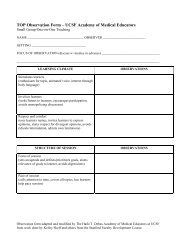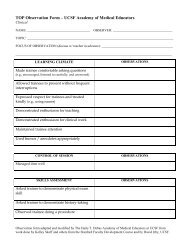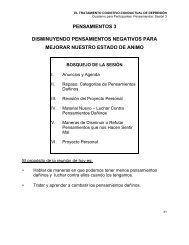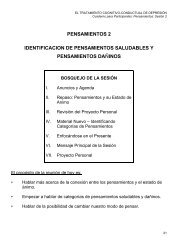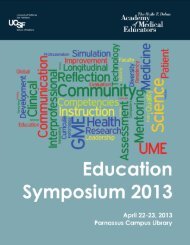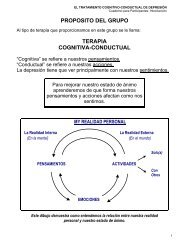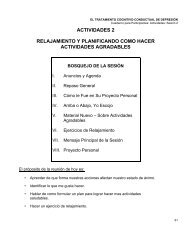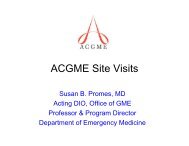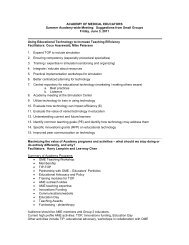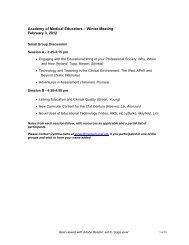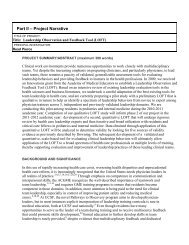2011 - UCSF School of Medicine - University of California, San ...
2011 - UCSF School of Medicine - University of California, San ...
2011 - UCSF School of Medicine - University of California, San ...
Create successful ePaper yourself
Turn your PDF publications into a flip-book with our unique Google optimized e-Paper software.
<strong>UCSF</strong> Education Day <strong>2011</strong>standardized patient examination.Background: Risk behaviors tend to cluster andsmokers in particular are likely to engage in multiplerisks. Treating multiple risk behaviors improves patienthealth outcomes and reduces health care costs.Methods: Using a randomized experimental design,medical students’ counseling interactions wereevaluated with a standardized patient presenting withsexual health concerns and current tobacco use withvaried problematic drinking status (alcohol-positive oralcohol-negative). Participants were 156 third yearmedical students at the <strong>University</strong> <strong>of</strong> <strong>California</strong>, <strong>San</strong>Francisco. Checklists completed by standardizedpatients evaluated students’ clinical performance. Afterthe encounter, students completed surveys <strong>of</strong> theirknowledge and attitudes for treating smokers withalcohol problems.Results: Overall, most students assessed tobacco use(85%); fewer assessed alcohol use (54%). Relative tothe alcohol-negative case, students seeing the alcoholpositivecase were less likely to assess STD history(80% vs. 91%, χ2(1)=4.15, p=.042) or patients’readiness to quit smoking (41% vs. 60%, χ2(1)=5.01,p=.025) and endorsed greater attitudinal barriers totobacco treatment, F(1,155)=4.79, p=.030. Patientsatisfaction, expressed as willingness to continuemedical treatment with the student doctor, wassignificantly lower for the alcohol-positive than thealcohol-negative case, χ2(1)=5.18, p=.023. Clinicalperformance ratings moderated the relationship betweenpatient case version and patient satisfaction.Discussion: When presented with a case <strong>of</strong> multiplerisk behaviors (sexual health, tobacco and alcohol),medical students performed less effectively and receivedlower patient satisfaction ratings than with a caseinvolving fewer behavioral risks. Findings weremoderated by ratings <strong>of</strong> students’ overall clinicalperformance.Reflective critique: The findings support the need forparadigm shifts in medical education that emphasizeassessment <strong>of</strong> multiple risks, new models <strong>of</strong>conceptualizing behavior change as a generalizedprocess, and treatment <strong>of</strong> the whole patient foroptimizing health outcomes.Physical Examination Teaching: ASystematic Review <strong>of</strong> the LiteratureSomnath Mookherjee, MD, <strong>UCSF</strong>, Department <strong>of</strong><strong>Medicine</strong>, Division <strong>of</strong> Hospital <strong>Medicine</strong>,SMookherjee@medicine.ucsf.edu; Lara Pheatt, MA,<strong>UCSF</strong> <strong>School</strong> <strong>of</strong> <strong>Medicine</strong>, Office <strong>of</strong> Medical Education,PheattL@medsch.ucsf.edu; Calvin L. Chou, MD, PhD,<strong>UCSF</strong> and VA Department <strong>of</strong> <strong>Medicine</strong>, Division <strong>of</strong>General Internal <strong>Medicine</strong>, calvin.chou@ucsf.eduAreas abstract covers: UME, GME, CMEDomain(s) addressed: Clinical Instruction andPerformance, Evaluation <strong>of</strong> Programs and Curricula,Patient CarePurpose: To review physical examination (PE) teachingmethods studied in the literature, summarize findings,and recommend best practices.Background: Physicians must be competent in the“synthesis” <strong>of</strong> PE data to make optimal patient caredecisions. Recent reports have bemoaned theinadequacy <strong>of</strong> physicians' PE skills; however, mostschools teach a comprehensive PE without links topatient care. Therefore, PE education needsimprovement, but the most effective teaching methodsare unknown.Methods: We included all publications <strong>of</strong> PE teachingpublished from 1951-<strong>2011</strong> that studied the effects <strong>of</strong> acurricular intervention and reported on teaching efficacy.Data extracted included organ system targeted, studydesign, types <strong>of</strong> curricula, measurements <strong>of</strong> efficacy,and domains <strong>of</strong> PE learning (psychomotor skills,knowledge, communication, and “synthesis” <strong>of</strong> data intoclinical application).Results: Of 3665 papers retrieved, 121 met inclusioncriteria. The most represented organ systems werecardiovascular, musculoskeletal, gynecological, andgeneral (multiple organ systems or comprehensive PE).Sixty-six (55%) studies included control groups. Majorcategories <strong>of</strong> educational interventions includedsimulation with standardized patients (SPs), simulation<strong>of</strong> aspects <strong>of</strong> PE (such as recordings <strong>of</strong> heart sounds),bedside teaching, and peer examination or tutoring.Common assessment methods included checklists withobserved structured clinical examinations, written tests,and surveys <strong>of</strong> learner satisfaction and self-assessedcompetence. Psychomotor skills and knowledgeacquisition were the most common competenciestargeted; seventeen papers (14%) were judged to teachPE in the “synthesis” realm.Discussion: Despite heightened awareness <strong>of</strong> theimportance <strong>of</strong> PE skills in guiding patient care, we foundfew curricula that taught PE “synthesis.” Heterogeneity in<strong>University</strong> <strong>of</strong> <strong>California</strong>, <strong>San</strong> Francisco • <strong>School</strong> <strong>of</strong> <strong>Medicine</strong> 37



